Separate digital solutions for sales, marketing, and eCommerce used to be popular about a decade ago. But the market situation has changed. Today, B2B and B2C companies rely on integrated solutions that can thoroughly digest customer insights, making each client “visible” to multiple departments at a time in order to deliver instant personalized offerings through all possible channels.
With the SAP Customer Experience (CX) suite, you can cover every aspect of business management, get a 360-degree view of your customer, and effortlessly offer advanced customer experiences.
Who Is SAP?
SAP is a multinational corporation headquartered in Germany. The acronym stands for Systems, Applications, and Products in the data processing. The company designs enterprise-level software products that streamline business processes and build exceptional customer relationships.
For many years, SAP has been named the leader in Gartner’s Magic Quadrant for categories such as digital commerce, warehouse management systems, and data integration tools. In 2019, SAP has been announced a Leader for Digital Experience Platforms in the Forrester Wave.
What Is the Secret of SAP’s Stable Leadership?
Over the years, the company has created a fully integrated ecosystem for eCommerce businesses consisting of numerous modules, products, and solutions that are both out of the box and customizable. That makes SAP a commerce market giant who can offer anything you need to interact with your customers, from their first contact with your brand through to the moment of purchase and after-sales support.
SAP offers its business database SAP HANA (High-Performance Analytic Appliance) as the foundation for creating intelligent enterprises. This flexible computing engine is available in on-premises, cloud, and hybrid deployment models. Among its capabilities are in-memory data processing, simplified data management, advanced real-time analytics, and the ability to develop next-generation apps.
The flagship products running on the SAP HANA database are:
- S/4HANA — an ERP business suite used by the back office departments running your entire business process. A harmonized UI helps them handle large amounts of data and streamline operations such as planning, ordering, manufacturing, delivering, etc. S/4HANA is available in the cloud and on premises.
- C/4HANA (formerly SAP Hybris) — a customer experience (CX) suite of cloud solutions for marketing, sales, retail and CRM, extensible via the SAP Cloud Platform. This is the frontend suite for SAP S/4HANA that can be used separately or integrated with other SAP products.
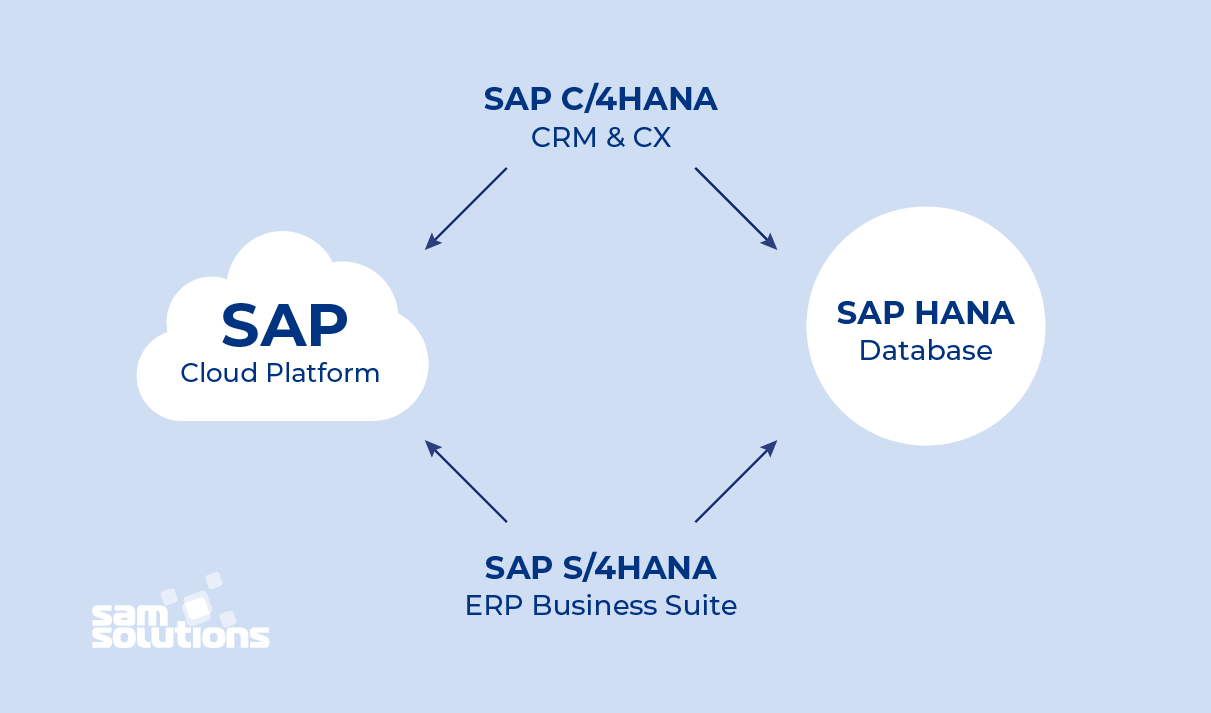
What’s more, the SAP Cloud Platform can be consolidated with the top three public cloud providers — Amazon Web Services (AWS), Google Cloud Platform and Microsoft Azure.
SAP CX — the Future of Customer Relationship Management
The Customer Experience suite is more than a CRM in the traditional sense. It is tailored to the client-oriented epoch that we live in, where each purchaser expects instant interaction with brands regardless of time and place, and where brands must do their best to get to know their client intimately.
In the brand name C/4HANA, “C” stands for the customer, “4” represents the fourth-generation CRM, which places the customer at the center of everything, and HANA is the database it runs on.
Taking advantage of SAP Hybris units and having incorporated them into microservices and machine learning, the company has made a huge leap forward in providing advanced real-time customer engagement. It has created a solution that transforms the traditional way of selling products and services: the software is not about pure transactions anymore, but about long-term relationships.
SAP C/4HANA is a combination of sales and marketing, a CRM working in tandem with an ERP system. Sitting on the cloud platform, it is supplemented by machine learning (ML) and artificial intelligence (AI) capabilities.
It is also able to collect and analyze data from various sources through the integration with the SAP HANA Data Management Suite.
How Does C/4HANA Work in Practice?
If sales, marketing and customer service department modules in a traditional CRM are functioning separately, C/4HANA unifies them into a coherent system. In other words, C/4HANA makes all departments work as one so that each participant is automatically notified of all business activities.
For instance, when a new marketing campaign is launched, the sales team is notified about the product’s price and other characteristics. This means that sales managers automatically get the information they need to create personalized offerings that will entice customers to buy from them.
Consider another hypothetical: a person registers on your website and agrees to their personal data being processed. This is the moment when a potential customer gets in touch with your brand. And this is the moment when your marketing and customer service teams should come into action.
As soon as a potential customer has signed up, these two teams are automatically notified of what the person searched for, and are able to start collecting and analyzing data in order to tailor the content and offerings to this person’s needs. Such practice facilitates the establishment of long-term relationships between businesses and their customers.
The Structure of the SAP Customer Experience Suite
Five industry-leading cloud-solution portfolios comprise SAP C/4HANA.
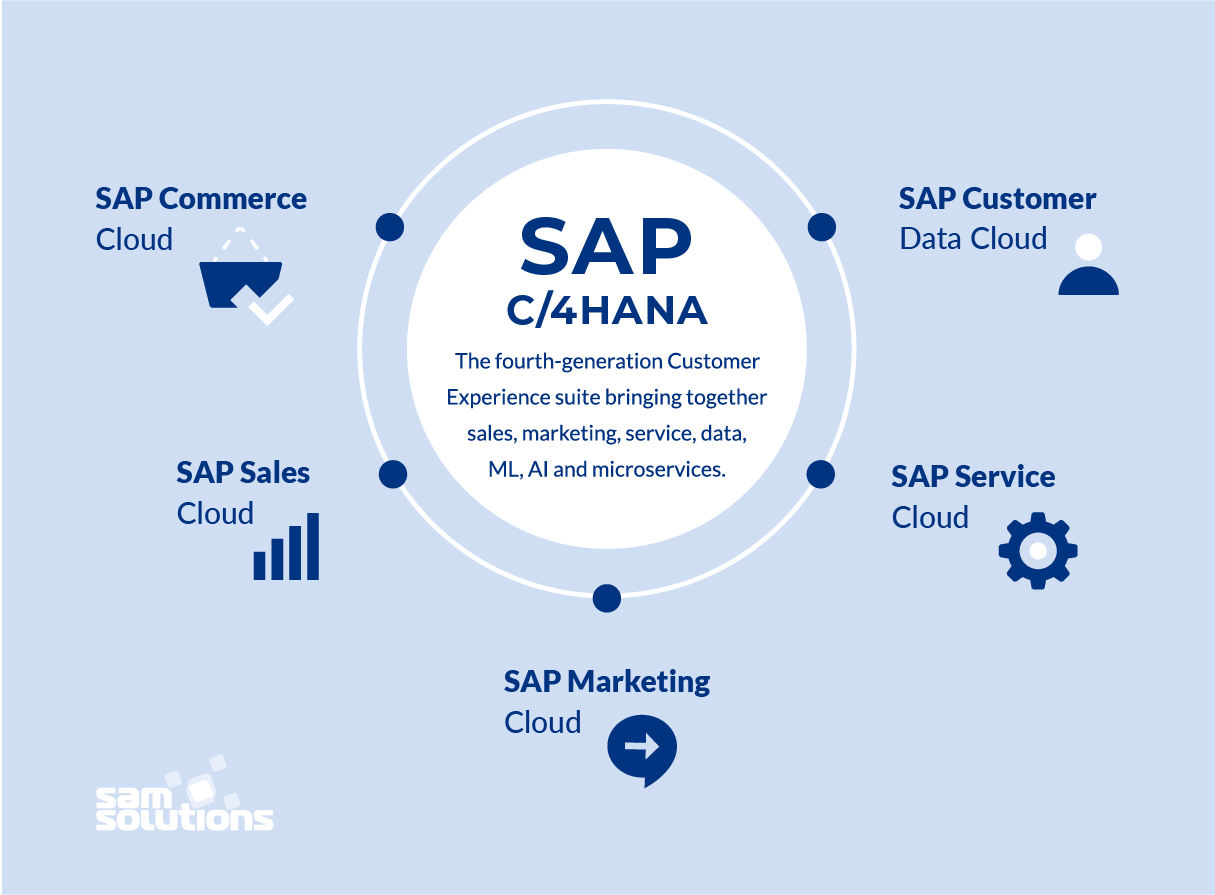
1. SAP Commerce Cloud
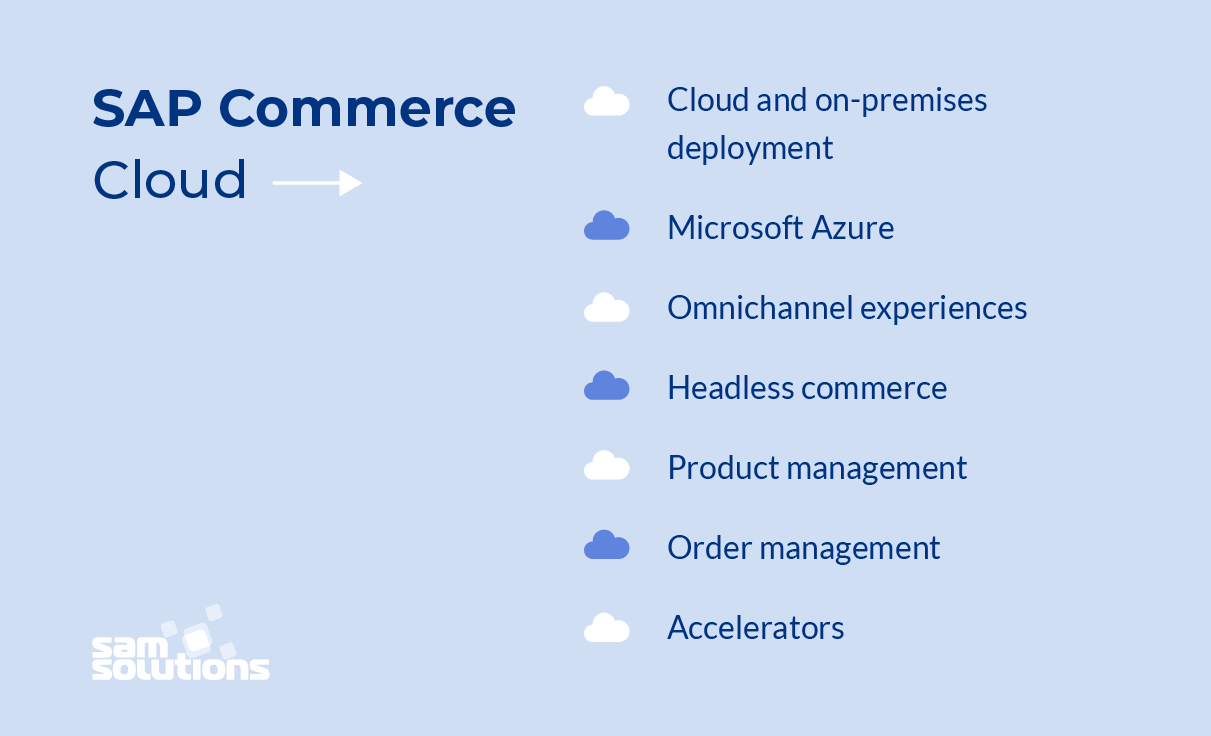
Originally named SAP Hybris Commerce, this all-in-one commerce solution based on Microsoft Azure easily addresses high expectations of B2C, B2B, and B2B2C businesses. What are the core SAP Commerce Cloud capabilities?
Omnichannel commerce
By supporting the diversity of go-to-market models that different companies use, and by leveraging the headless commerce approach, SAP Commerce Cloud provides omnichannel sales and marketing experiences. This means that you can reach your customers through multiple touchpoints, including web, mobile, POS, social networks, interactive kiosks and more.
Accelerators
Small and midsize enterprises from various industries can adapt the system to their unique requirements due to out-of-the-box industry-specific accelerators.
There are accelerators for the financial, travel and telecom industries, and for local government agencies. Such modules are designed with the focus on these specific sectors, so they can meet their challenges easily.
Product management
Product information is stored in a centralized content repository which is used to manage large amounts of product items simultaneously. Users can :
- сreate catalogs based on various attributes;
- upload images;
- publish and edit descriptions;
- define pricing rates;
- define rules for personalized offers.
This helps users save time and ensure data consistency.
Order management
For companies, it’s a serious challenge to coordinate orders coming in from numerous touchpoints.
Commerce Cloud achieves end-to-end inventory visibility by centralizing order and inventory management in real time across the organization. If the goods are in stock, they can be ordered; as soon as the goods are sold out, they become unavailable for order. This eliminates the loss of face that a business can experience when a customer places an order, only to later be notified that the item is out of stock.
Both cloud and on-premises deployment models are available.
2. SAP Sales Cloud
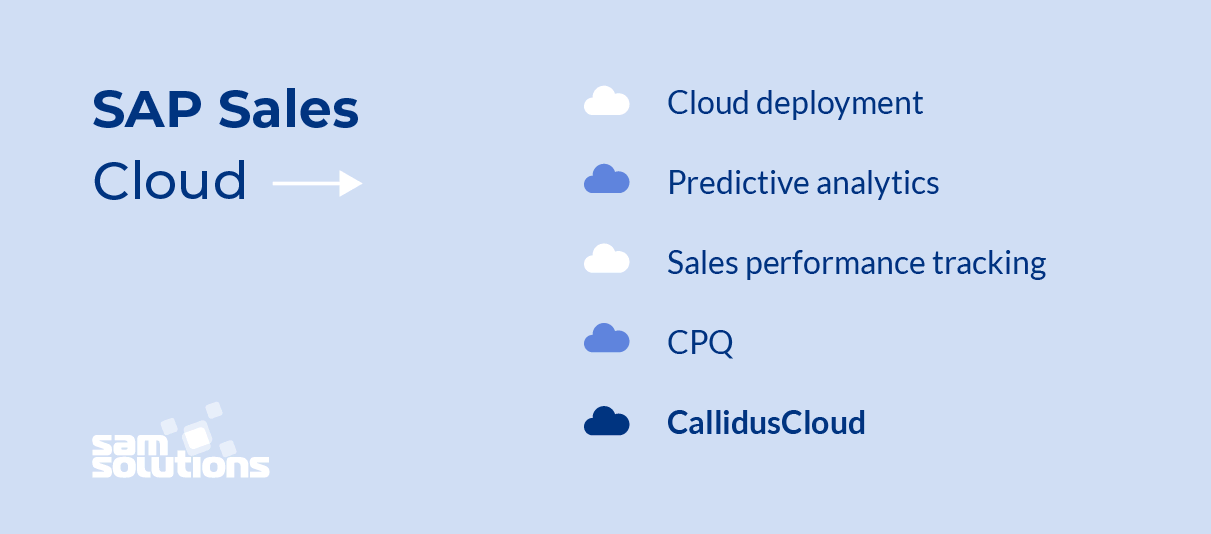
Quite often it happens that users are interacting with a company through various channels, but the sales team has no real visibility into those interactions. As a result, the company has no chance to impact the decision-making of the potential client and improve its sales.
SAP Sales Cloud is the world’s most complete sales software unit. This is a pure cloud, mobile-first solution that can help you sell your products or services more effectively by organizing successful sales activities based on your overall control of the customer’s buying journey.
What do you get?
- An easy-to-use dashboard for sales performance management
- A customizable home page with detailed information on metrics such as KPIs
- Full real-time engagement with your customers
- Configure, price and quote (CPQ)
- Customer feedback management
- Predictive analytics provided by the Deal Finder and the Influencer Map tools
- Smooth integration with your business systems and other SAP products
By monitoring customer behavior via the Sales Cloud, you will gain valuable insights that you can turn into effective actions. This will be your best opportunity for converting leads and driving sales.
In 2018, SAP acquired Callidus Software, a company specializing in sales performance management. CallidusCloud now extends Sales Cloud with its modules for sales automation.
3. SAP Marketing Cloud
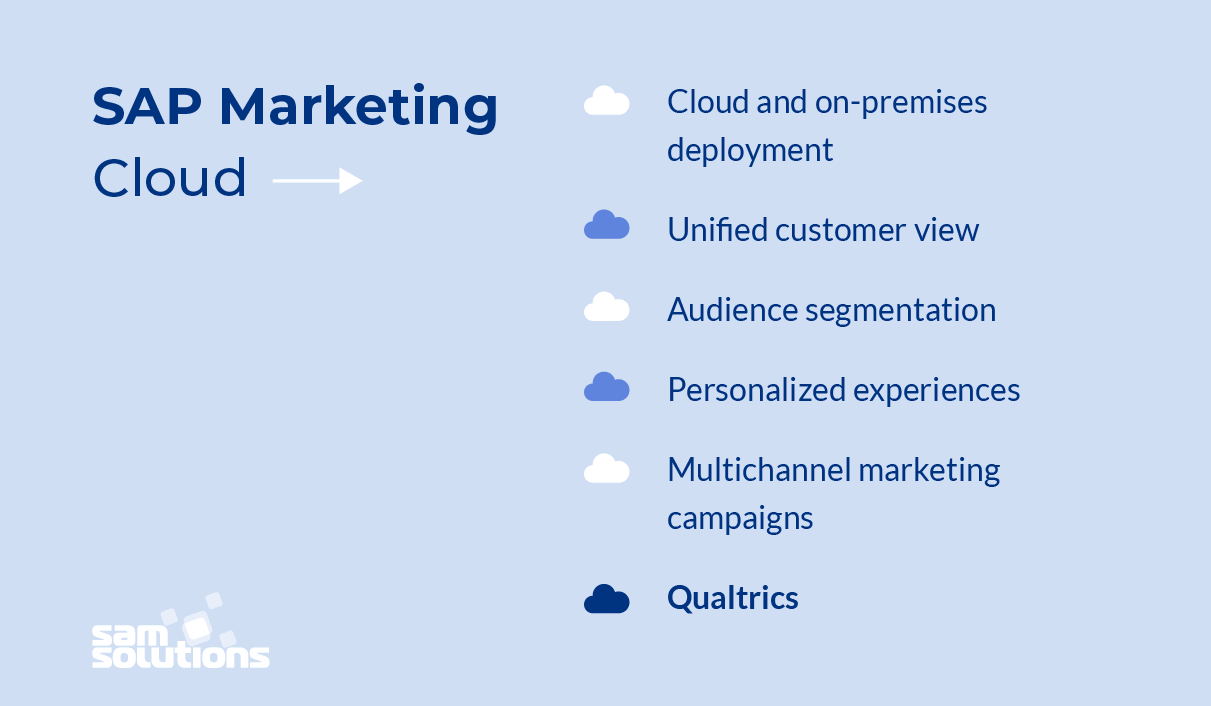
Marketing is a trusted source of business success, and if you optimize marketing and treat customers as individuals, you will drive your revenue significantly. But you should focus your efforts on audiences that are profitable. The question is, how do you find them?
Using SAP Marketing Cloud tools, you can get a deeper understanding of your customer interests, sentiments and behavior with the help of a profile dashboard, the sentiment engagement tool and the customer journey insight tool. Due to an easy-to-understand visual interface, you can see a unified customer view as well as a high-volume segmentation of your audience. You can consolidate all your company marketing plans, analytics, KPIs, budgeting and tracking into a single view.
This helps you identify target groups, which is the basis for creating successful personalized marketing campaigns. Such campaigns can automatically run across multiple channels, such as email, social media or SMS, and react quickly to changes on the market.
To strengthen its business marketing solution, SAP also acquired Qualtrics International Inc., the world’s leading customer experience and feedback management platform. Together, SAP and Qualtrics have created a unique business proposal that enables the implementation of end-to-end processes and operational management systems working on the basis of customer opinions, needs and desires.
Both cloud and on-premises deployment models are available.
4. SAP Service Cloud
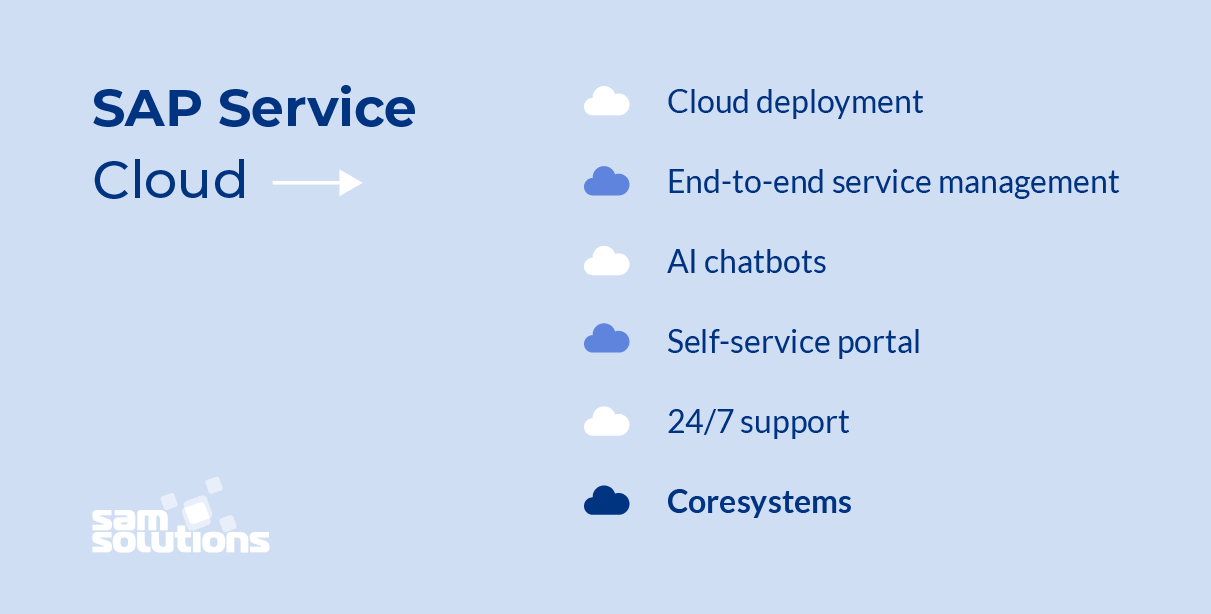
Why can poor customer service experience dent a firm’s reputation and reduce sales? Today’s clients expect instant problem-solving from your customer support service, and if they don’t get seamless interaction, they are likely to abandon your brand and switch to your rivals.
SAP Service Cloud is an end-to-end service management solution that enables unified processing of users’ queries across every channel before and after purchase, keeping your clients happy and loyal.
The support service is based on conversational AI chatbots that use advanced language processing to imitate natural conversation and deliver a high-quality experience. Chatbots are available 24/7, which means that users get consistent and attentive help and the call-center staff do not get exhausted.
If a chatbot can’t resolve an issue, it transfers full notes from the chat to a human agent who instantly continues the conversation with the user.
Service Cloud integrates with Commerce Cloud solutions, other platforms and tools in a single user interface, providing a full overview of the customer journey.
To extend its service offering, SAP acquired the Swiss software company Coresystems, a developer of field service management (FSM) software. Coresystems added the self-service portal to SAP’s functionality.
5. SAP Customer Data Cloud
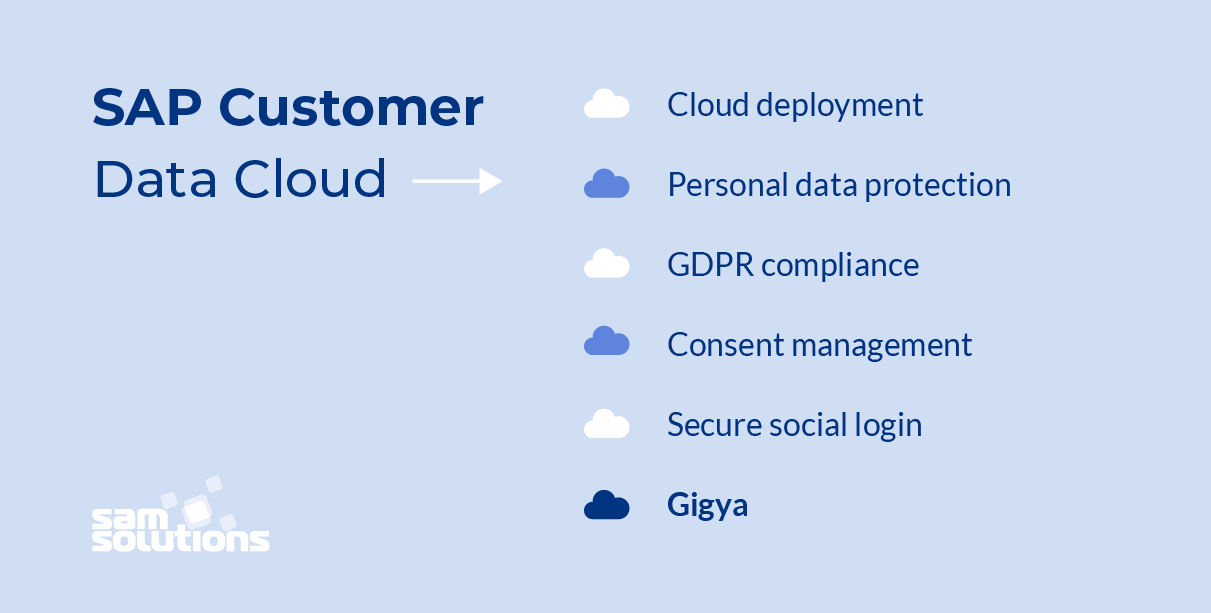
Great customer experience should be based not only on convenience and personalization but on trust, too. For example, you can earn your customers’ trust by collecting and processing their personal data only in accordance with their consent and legislation.
The SAP Customer Data Cloud is an advanced customer data management solution designed to help businesses address data protection regulations, while still engaging meaningfully with their customers. More precisely, it complies with the General Data Protection Regulation (GDPR) — the core EU consumer data-protection and privacy law.
Customer Data Cloud capabilities:
- Secure registration and login
- Authentication and consent management
- Customer profile creation and analysis
- Accurate audience segmentation
- Data unification and consistency across the entire ecosystem due to the integration with Marketing and Commerce clouds
Offering users data transparency and control means engaging with them on their terms, which can help you gain their trust during and long after your digital interaction.
How do you benefit from permission-based data?
- You demonstrate respect to consumer privacy and build a loyal audience.
- You gain a deeper understanding of your audience.
- You create unobtrusive personalized offerings in line with user needs.
In 2017, SAP acquired the Israeli company Gigya, which specializes in the development of identity management software. This helped SAP extend the Data Cloud with new capabilities for brand and consumer communication. For instance, SAP enabled secure social login in compliance with the GDPR, allowing users to leverage their social media profiles to quickly register on online portals.
Use SaM Solutions’ SAP Commerce Cloud implementation to build a highly customizable ecommerce solution with complex catalogues and configurations.
Why Is C/4HANA the Best for Customer Engagement?
To finish up this comprehensive overview of SAP CX cloud products, let’s recap what makes C/4HANA the best software for delivering end-to-end user experience and accelerating sales.
Customer Orientation
All SAP solutions place customers at the center of your business and help you shape your activities to their needs and desires. They fully correspond to the client-oriented market situation that has developed over the past years and aim at creating mutually beneficial relationships between brands and their clients.
Faster Time to Market
The platform is agile and scalable and responds quickly to any changes or new user needs due to microservices architecture, a bundle of extensions and integration capabilities. This makes it possible to customize the solution to your unique requirements and go to market in the shortest possible time.
All-in-One Solution
SAP has created a unique digital ecosystem that integrates everything you need for marketing, sales, customer service and commerce. Moreover, it ensures seamless integration with third-party systems. It’s more than enough for doing the eCommerce business effectively, isn’t it?



















 The Latest 15 Information Technology Trends in 2024
The Latest 15 Information Technology Trends in 2024 Top 10 Embedded Software Development Tools
Top 10 Embedded Software Development Tools IaaS vs. PaaS vs. SaaS: What’s the Difference?
IaaS vs. PaaS vs. SaaS: What’s the Difference? 10 Examples of Predictive Analytics
10 Examples of Predictive Analytics







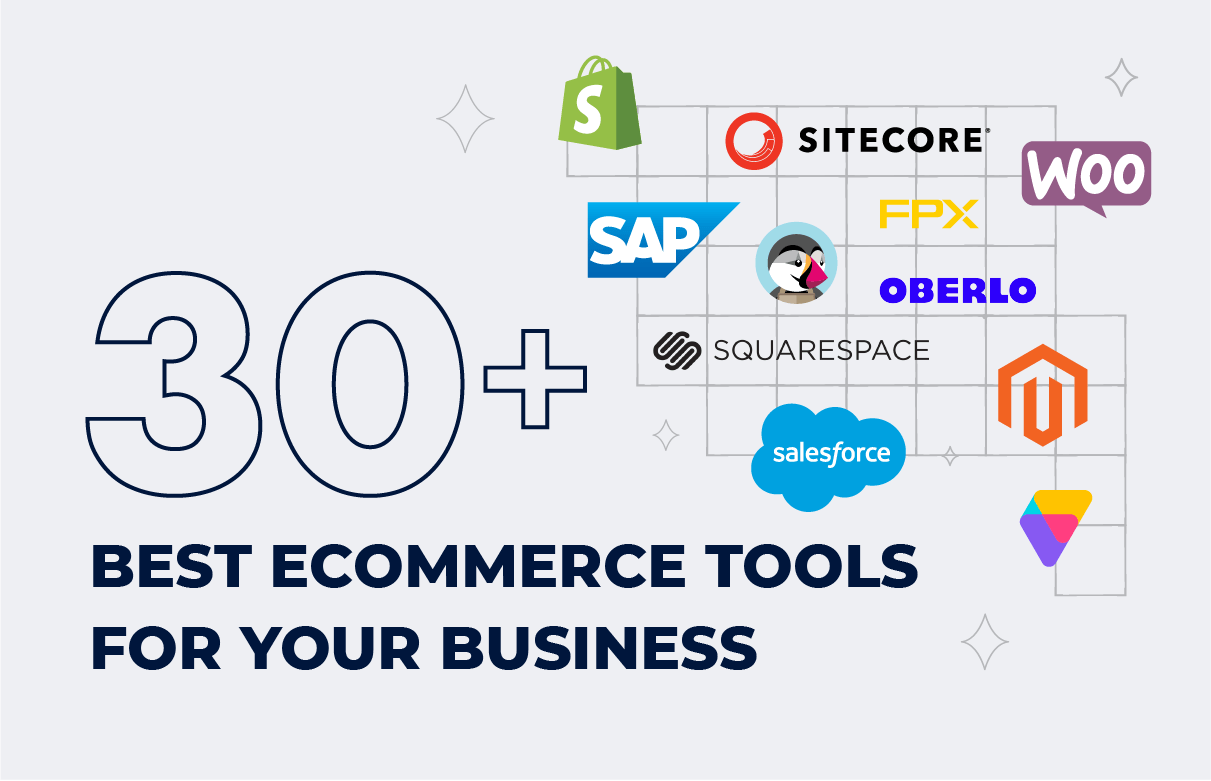


![What Is Ecommerce Customer Service? [Including 8 Best Practices]](https://www.sam-solutions.com/blog/wp-content/uploads/Customer-Service-in-eCommerce.png)
